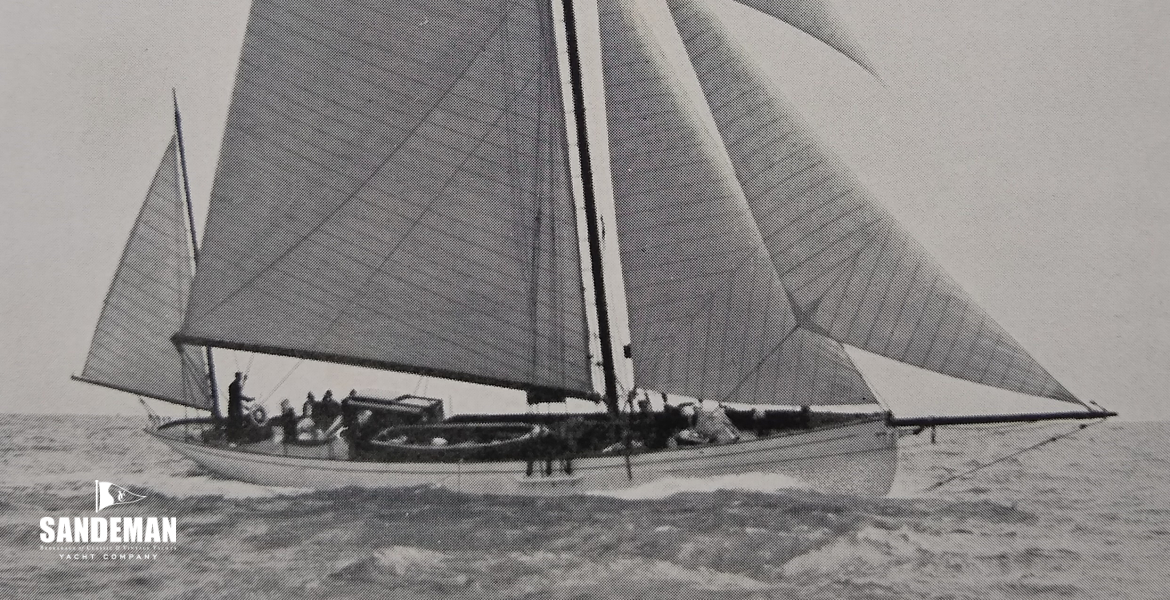
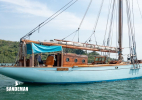
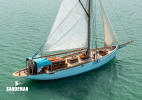
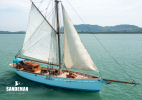
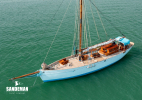
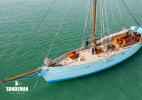
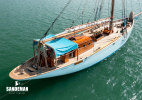
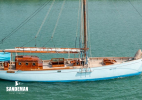

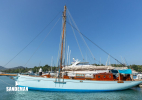
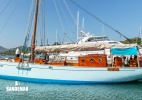
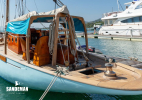
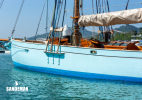
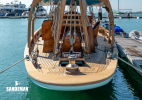

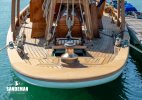
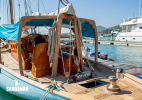
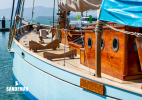
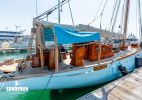
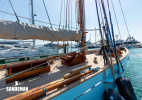

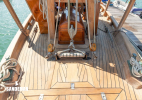
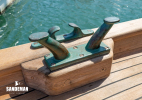
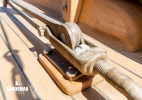
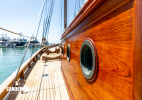
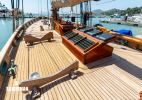
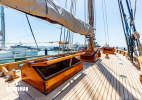
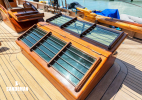
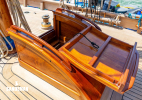
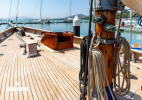
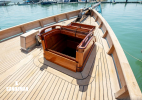
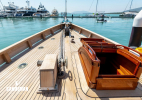
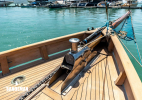
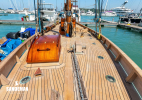
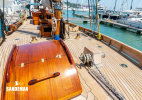
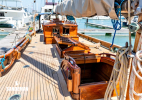
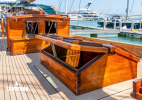
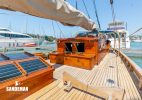
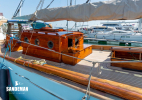
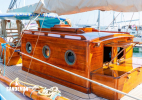
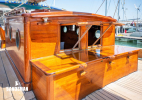
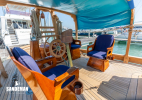
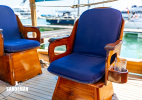
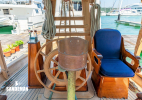
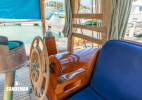
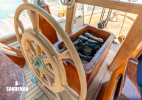
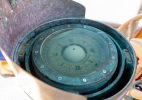
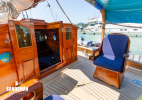
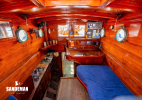
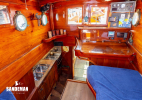
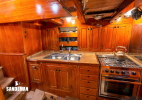
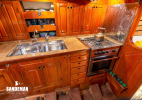
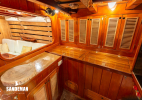
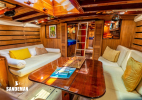
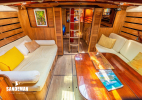
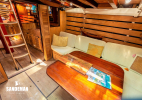
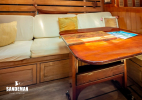

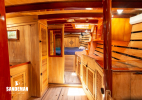
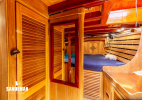
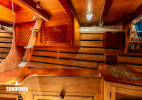
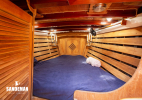

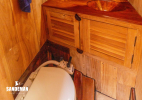

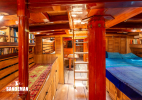
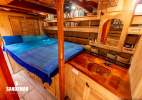
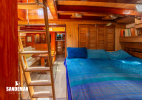
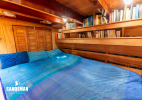


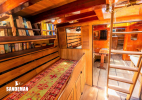
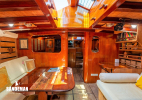
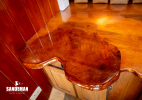

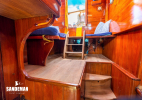
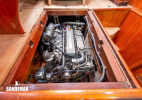
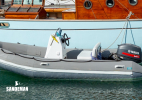
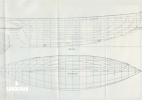
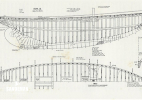
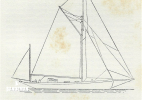
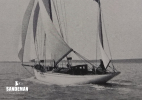
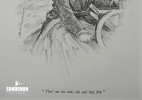
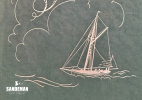
| Designer | Claud Worth |
|---|---|
| Builder | Philip & Son Dartmouth |
| Date | 1924 |
| Length overall | 73 ft 1 in / 22.28 m |
| Length deck | 62 ft 0 in / 18.9 m |
| Length waterline | 50 ft 0 in / 15.24 m |
|---|---|
| Beam | 13 ft 6 in / 4.11 m |
| Draft | 8 ft 6 in / 2.59 m |
| Displacement | 38 Tonnes |
| Construction | Teak on oak and chengal |
| Engine | Yanmar 4LHA-HTP 120 hp turbo diesel |
|---|---|
| Location | Thailand |
| Price | GBP 425,000 |
| Vat | VAT Not Paid |
These details are provisional and may be amended
Two of the most highly regarded and influential yachting books of any century, Claud Worth’s ‘Yacht Cruising’ (1910-1926), and ‘Yacht Navigation and Voyaging’ (1927-1935), reveal the evolution behind this yacht full of character, strength, ability, longevity, and seminal force. A vessel that might never have been given life were it not for a woman’s influence, that became ground zero in the career of probably the greatest ever yacht designer, Olin J. Stephens II. Like most yachts that have logged almost a century, LUCKY LADY - TERN IV has had her ups and downs, some mercurial owners, and necessary saviours. Her easy lines, stout construction, and that she was Claud Worth’s TERN IV won through. In current ownership since 2001 she has voyaged 50,000 miles to and through the south seas her first two owners dreamed of. And been given life and vitality by a couple with the hands-on ability and vision to ensure that LUCKY LADY - TERN IV has many more decades of voyaging in her while offering an incredibly comfortable and atmospheric home on the sea.
Interested in LUCKY LADY (EX TERN IV) in more detail.
Enquire About LUCKY LADY (EX TERN IV) Download PDF Specification
The captain of LUCKY LADY - TERN IV is a shipwright and has a carpenter crew working with him in Thailand. Our main carpenter was able to source seasoned teak and chengal for the restoration. Because we live and cruise on LUCKY LADY, we have tried to keep her strong and simple. We have sailed over 50, 000 nautical miles with her. The original topmast could be restored easily in Thailand as well as any changes of interior.
“… I tried to stick to the basics of clean, balanced lines, the avoidance of extremes in displacement and beam, and providing low wetted area to the degree permitted by adequate lateral plane. In overall geometry and keel profile I looked for guidance to the study I had made of TERNS III and IV, both designed by the British writer on deepwater cruising, Claud Worth.
“I have mentioned the influence of Claud Worth, the English doctor, writer, and designer, whose TERN IV I greatly admired. Those who know Worth’s boat and my BRILLIANT design may see this inspiration; both are shaped and built not as racing yachts but as sea boats intended to survive the worst weather and to make good passages.”
(On the design of BRILLIANT in ‘All This and Sailing Too’, 1999)
"We bought TERN IV in 2001 and have by now taken her apart and put her back together like new. The work was mostly done in Thailand where there are skilled shipwrights and tropical hardwood like teak and chengal can be found. She is a totally rebuilt classic yacht.
RESTORATION WORK IN CURRENT OWNERSHIP
2022 Phuket, Thailand
- Restoration of lazarette
- New frames at shrouds
- Refastened chain plates
- Total rebuild of main engine
2017 Phuket, Thailand
- Where necessary, oak frames under water line replaced in chengal
2009/2010 Phuket, Thailand
- New 1 ¾ inch Burmese teak deck
- Chengal (tropical hardwood: Neobalanocarpus heimii) frames or deck beams
- The teak is glued on 1 layer of ¾ in / 18 mm marine plywood sealed with 3 x layers fiberglass
- 22 x Custom made prism deck lights to brighten the interior
- 3 x New Burmese teak hatches and a teak pilot house
- Total refit and rebuild of interior including new electrical panel and wiring all through the boat
- New galley
- New water and fuel tanks
- Total overhaul, all fastenings checked and replaced where necessary in silicon bronze
- New chengal frames where necessary
- 12 x New (additional) silicon bronze keel bolts
- Existing keel bolts tightened
2003 Hawaii
- New main boom Oregon straight grain Fir
2002 Panama
- New interior saloon and forward in Panama Plantation teak
IN PREVIOUS OWNERSHIP
1997
- New Rudder
1990 Dartmouth, UK
- Refastened with 3500 silicon bronze screws
PHILIP & SON LTD. YARD NO. 658
UK NATIONAL HISTORIC SHIPS REGISTER No. 730
"... probably one of the finest designs of her size ever built. Her midship section is a masterpiece - exactly what it should be and TERN IV's behaviour at sea is sufficient proof of perfection in her design and ballasting." T. Harrison Butler
Dr Claud Worth had been more than happy with his 53 ft cutter TERN III, built at Whitstable in 1914. Self-designed (with a level of assistance by Albert Strange still debated between Strange groupies and Worth disciples), with input from decades of such studious research into the way of a cruising yacht, by observation and the logging of thousands of seagoing miles, that one wonders how he had time to become equally prominent and influential in his day job as a Harley Street ophthalmologist.
By 1922 Worth’s wife Janet desired more comfort and space. Comfort at sea being Royal Cruising Club Vice-Commodore Claud Worth’s watchword, and, as one of his friends had once quipped, “One good TERN deserves another”, he spent a year working from 5 to 8 in the morning preparing the drawings and specifications of a larger TERN III with refinements from lessons learned. Although the structural specifications were almost identical, he took the opportunity to pocket the all sawn and doubled frames into the wood
keel and bolt them through from side to side. And her floors were of galvanised mild steel rather than TERN III’s oak crooks.
The £2,750 build contract went to Philip & Son of Dartmouth who, in tandem, built a second vessel to the design: GRACIE III (now ALZAVOLA). Whilst this might have been a feather in Worth’s cap, the result was significantly late delivery of TERN IV: in the autumn of 1924 instead of the spring. Apparently GRACIE III’s owner, Yorkshire wool mill owner and merchant Walter Ramsay Kay, could shout louder, and the Devon yard hadn’t bargained on Worth being a stickler for rigid adherence to his structural and materials specifications.
So TERN IV’s highly successful shakedown cruise wasn’t until May 1925 from Cowes to Vigo, NW Spain, and back to Falmouth. Worth concluded: “TERN IV runs as steadily and safely and is as easy a sea-boat as TERN III; one could give her no higher praise than that… She is wonderfully handy and easily worked.”
A summer 1926 ‘Cruise to Atlantis’ was to be Worth’s last as ill heath caught up with him, but what an ambitious and thrilling swansong. 11 days out from Falmouth to the Azores, and on the return only 7 days, 13 hours, 40 minutes from Horta to the Lizard, running before a gale that saw TERN IV reeling off five consecutive 200-mile days.
In second ownership by a good friend of the Worths, Dorothy Una Ratcliffe - sailor and adventurer, fabulously wealthy socialite, writer, poet, traveller, collector - voyaging continued to the manner born. From 1928 to 1937, as SEA SWALLOW, she visited the Channel Islands, northern France, Ireland, Denmark, Germany, Norway, Sweden and Finland. The King’s Sailing
Master, Douglas Dixon, shipped aboard for the 1932 passage to the Baltic. Impressions from these voyages in the form of prose, poetry, and even plays appeared in Dorothy Una Ratcliffe’s delightful 1937 book 'Swallow of the Sea'.
Then in 1937, in the ownership of the now late Claud Worth’s nephew, Thomas, she became TERN IV (OF BAR) again, with a home mooring on the Helford River, Cornwall, near Claud and Janet Worth’s retiral place, Bar, Mawnan Smith. The greater Falmouth area would be TERN IV’s home into the late 1960s, including riding out the Second World War in a mud berth,
and, post-war, moored at St. Mawes as a bermudan yawl. No tales of great adventure emanate from this period; we presume she was loved and cared for, and her teak hull and copper bottom kept her sweet.
It would be retired merchant mariner, educator in navigation, and adventurer under sail, Roger Fothergill and his wife Joy who would lead TERN IV back to deep and blue water adventure. At some point after their 1967 purchase, she crossed the Atlantic to begin a new life of Caribbean charter with Joy as mate and chef. Dissatisfied with the bermudan rig, in
around 1970 she re-crossed the Atlantic to be re-rigged in England as a gaff cutter with a sailing barge-like standing gaff and brailing mainsail. It was an arrangement that really worked for short-handed sailing, that looked completely normal under sail, but strange at rest. After TERN IV’s third Atlantic crossing in 1971, she resumed her C aribbean career with the Fothergills for a further 10 years.
After brief ownership from 1981 by Englishman Peter Baker, in 1984 TERN IV again crossed the Atlantic west to east into Portuguese ownership. Five years on she was seen and purchased, “languishing on a mooring off Faro in the Algarve… in a sorry state but sound and with a new suit of sails more or less seaworthy”, by Charles Watson, looking to start a classic charter business based in the southwest of England. By spring 1990 she was in refit at Old Mill Creek, Dartmouth by Pete Nash and John Holden, including refastening
with well over 2000 silicon bronze screws, drawing of keelbolts with only one replaced, the consequential garboard replacement, and, apart from the mainmast, all new spars to give TERN IV a conventional gaff yawl rig.
By the summer of 1990 she was filming as Jack Rolfe’s “XANADU” for the BBC’s yachting soap ‘Howard’s Way’. Charles Watson and TERN IV worked together in the charter business for 11 years. When Watson settled on Madeira he decided to sell, and in 2001 her life in present ownership began in Cornwall and is ongoing in Southeast Asia where she has been extensively maintained and refitted as described above.
©2025 Iain McAllister/ Sandeman Yacht Company Ltd.
Carvel 1¾ in / 44 mm Rangoon teak planking
- 4 x 4 in / 100 mm x 100 mm sawn English oak frames in pairs
- Frames more closely spaced than Lloyds prescribed by Lloyd's Register
- Some frames replaced in chengal (tropical hardwood)
- Silicon bronze fastened (1990/ 2010)
- New silicon bronze keel bolts 2010
- Burmese teak deck laid on fiberglass and plywood
- Burmese Teak superstructures
- Teak interior
- Edson double worm gear steering
- 13 ton Lead external ballast keel
- 5 tons Internal lead ballast cast patterns set between frames
- ½ in Air space between lead and planking
- Each lead cast has the name Tern IV stamped on it
GENERAL
- Teak laid deck
- Raw teak bulwarks topped with 4½ in / 112 mm raw teak capping
- 22 x Deck prism lights all along the deck
FROM AFT
- Small platform with 2 small fluch hatch lockers under deck
- Flush hatch access to deck washdown hose and ventilation of lazarette
- Bronze Barient 32 main sheet winch
- Main sheet block system on buffer
- Bronze mooring cleats and associated fairleads starboard and port
- Bronze Laurent Giles type backstay levers starboard and port
COCKPIT
- 3 x Custom made Teak chairs
- Period binnacle compass by B. Cooke & Son Ltd., Hull
- Round steering chair built over the worm drive steering system and autopilot
- Teak ship's wheel
COMPANIONWAY DECKHOUSE
- Double doors with windows and sliding hatch
- Storage boxes forward for life raft and propane gas bottle
- 3 x bronze portholes on each side of the house
- 2 x Hinged glass windows at front
- Varnished teak grabrails port and starboard
MID DECK
- Raised butterfly skylight over saloon, middle
- Bronze cleats
- Custom made dinghy cradle, port
- Custom made round hinged main cabin hatch in the middle
- Barient bronze boom halyard winch
MAIN MAST POSITION
- Bronze Arco Hutton 56 winches port and starboard
- 3 x Vintage bronze halyard winches at mast
- Double pin rail port and starboard
FOREDECK
- Scuttle forehatch to starboard
- Teak channel for anchor chain
- Stainless steel bowsprit bits with Samson post and cleats
- Bowsprit with traveller
- Stainless steel anchor roller to port
- 2 x Bronze mooring fairleads
GROUND TACKLE
- Anchor windlass 24V
- 220 ft galvanised BBB anchor chain
- 1 x Custom anchor 150 lb / 68 kg
- 1 x Rocna anchor 75 lbs / 34 kg
GENERAL
- Sleeps 7 people in 3 cabins
- All interior in Panama plantation teak and Burmese teak with louvered bulkheads and cabinets.
- Panama teak waterfall cabin sole with cocobolo trimmings
- Deckhead of laminated natural teak on varnished chengal beams
COMPANIONWAY DOGHOUSE
- 3 x Steps down stair from deck
- Main engine cover
- One bench starboard one corner seat port
- Chart table with drawer
- Engine controls
- Navigation and communication equipment
- Airy lazarette with lots of stowage space aft in overhang behind stair
GALLEY
- 4 x steps down to galley
To Port
- Marble work tops
- Louvered storage cabinets
- Double stainless steel sink with saltwater and freshwater foot pumps, Jabsco pump
- 4 x Burner Force10 gimbaled stove and oven
Starboard
- Workspace, marble
- 2 x Isotherm fridges 12 V and 24 V in teak boxes
- Louvered cabinets
Bulkhead with opening to saloon on starboard side
SALOON
To Starboard
- L-shaped settee around original gimballed mahogany table
- Stowage space underneath
To Port
- Bookshelf, cabinet and table on port side
- Double bed with lockers underneath
- Bulkhead with louvered folding door and 2 x louvered windows to main cabin
MAIN CABIN
- Double berth to port; bookshelf
- Adjoining vanity with wooden sink
- Single bunk starboard, bookshelf
- Stowage cabinets underneath
- Ladder to hatch in the middle
Mainmast position
- Cabinet with marble top starboard
- Stowage cabinets on both sides
- Toilet with hand pump, wooden sink, louvered door
DOUBLE GUEST CABIN FORWARD
- Lockers under it
- Big forward locker
OTHER EQUIPMENT
- 9 x 24 V Fans
- Multiple deck prism lights
RIG
Tern IV was originally a yawl for aesthetics and steadying at anchor, with a tiny mizzen. The present owners unstepped the mizzen and have sailed her as gaff cutter with a small gaff main. The boat previously set a fidded topmast, and this could be reinstated.
- Varnished solid pine keel-stepped mast
- Main boom (straight grain Oregon Fir 2003)
- Tropical hardwood bowsprit
- Downwind goosewinging pole
- Single set of spreaders
- Shrouds led outboard to channels
- Running back stays in flexible stainless steel to large bronze Highfield levers
SAILS
- 1 x Gaff main sail (Zoomsails 2017)
- 1 x Staysail (old)
- 1 x 150 jib (2010)
CANVASWORK
- Hatch covers, Sunbrella beige
- Sail covers, Shelter-Rite beige (2022)
- Bowsprit cover Shelter-Rite beige (2022)
- Winch covers Shelter-Rite beige
- Cockpit awning
- Cockpit seats cushions, Westmarine blue Sunbrella
MECHANICAL
- Yanmar 4LHA-HTP 120 hp turbo (totally rebuilt in 2023)
- Bronze propeller
- Edson worm drive steering
ELECTRICAL
- 2 x Honda 2200 portable petrol/ gasoline generators
- 240 V on board power
- 24 V
- 12 V
- Battery charger 12 V and 24 V
- Inverter
- 4 x D8 Batteries 24 V, 150 A (by engine)
- 4 x D8 Batteries 12 V, 150 A (forward under bunk)
- 12 V Alternator
- 24 V Alternator
TANKAGE
- 1 x Stainless steel water tank 400 L (under salon floor)
- 1 x Teflon water tank 100 L (under main cabin floor)
- 3 x Iron diesel tanks each 400 L (starboard and port next to engine)
- All independently switched and filtered
NAVIGATION
- GPS
- Depth sounder
- Simrad autopilot for worm drive
- AIS
- Computer with GPS
COMMUNICATIONS
- Iridium Satellite phone
- Weather by computer and sat phone
- Handheld VHF radio
- 1 x Liferaft
- 6 x Life vests
- 1 x 24 V Rule 2000 bilge pump
- 1 x Manual bilge pump
- 2 x Fire extinguishers
- Spreader lights to illuminate deck
- Blue flashing lights on spreaders for emergency situations
- Tri-colour masthead light; with running lights; anchor light; strobe light
- 1 x Dinghy: Bombard/Zodiac 4.7 m
- 40 hp Yamaha Enduro outboard motor
- 2 x Kayaks
- Custom traditional wooden pole dinghy crane
- 4 x Custom inflatable fenders
- Deck wash pump
Contact us to discuss LUCKY LADY (EX TERN IV) in more detail.
These particulars have been prepared from information provided by the vendors and are intended as a general guide. The purchaser should confirm details of concern to them by survey or engineers inspection. The purchaser should also ensure that the purchase contract properly reflects their concerns and specifies details on which they wish to rely.